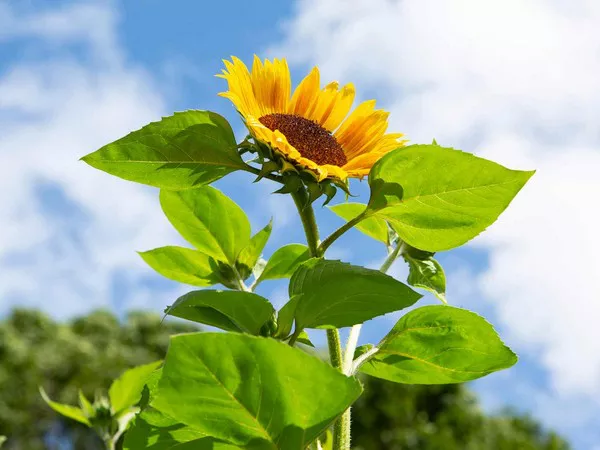Sunflowers, with their radiant yellow petals and imposing stature, are not just a sight to behold but also a powerful symbol that has captured the human imagination for centuries. These vibrant flowers have held various meanings and significance across different cultures and time periods.
Sunflowers in Art and Literature
Sunflowers have long been celebrated in art and literature for their striking appearance and symbolic richness. Perhaps the most famous ode to sunflowers comes from Vincent van Gogh’s series of paintings, including “Sunflowers” and “Sunflowers in a Vase.” Van Gogh’s sunflowers represent the artist’s admiration for the vibrancy of life and the idea of fleeting beauty. The sunflower’s yellow petals are seen as a reflection of the sun itself, evoking warmth, happiness, and vitality.
The Sunflower’s Connection to the Sun
The most obvious connection between sunflowers and their symbolism lies in their name and physical appearance. Sunflowers exhibit a unique behavior called heliotropism, where they follow the sun’s movement across the sky, always facing its warm rays. This constant tracking of the sun has led to their association with adoration, loyalty, and unwavering devotion.
Sunflowers as a Symbol of Adoration and Devotion
The sunflower’s unfaltering dedication to following the sun symbolizes unwavering adoration and loyalty. Giving a bouquet of sunflowers to someone can be a heartfelt way of expressing deep affection, friendship, or love. In many cultures, sunflowers are used in weddings to convey the message of a faithful and loving bond between the couple.
The Historical Significance of Sunflowers
Sunflowers have held cultural significance for centuries, particularly among Native American tribes. Some indigenous tribes used sunflowers for their healing properties, while others incorporated them into rituals and ceremonies. The Cheyenne tribe, for instance, used sunflowers in their Sun Dance ritual, a sacred ceremony dedicated to renewal and healing.
Sunflowers and Greek Mythology
In Greek mythology, the sunflower is associated with the story of Clytie, a water nymph who fell in love with the sun god Apollo. When Apollo did not return her affections, Clytie pined away, turning into a sunflower and forever gazing at the sun as it crossed the sky. The sunflower thus became a symbol of unwavering love and devotion.
The Sunflower’s Role in Religion
Sunflowers have also found a place in various religious traditions. In Christianity, sunflowers are sometimes associated with God’s love and the idea of turning toward the light of the divine. In Hinduism, sunflowers hold significance as offerings to gods, especially during the festival of Pongal. Their bright blooms symbolize the hope and abundance associated with a good harvest.
Sunflowers in Native American Culture
Many Native American tribes held sunflowers in high regard. The sunflower was a symbol of fertility and was used in various rituals and ceremonies. For some tribes, the sunflower represented the connection between humanity and nature, highlighting the importance of living in harmony with the environment.
Sunflowers as a Sign of Hope and Positivity
The bright, sunny disposition of sunflowers has made them a symbol of hope and positivity. Their vibrant yellow petals are reminiscent of the sun’s rays, and they are often given to uplift someone’s spirits or to celebrate a joyous occasion. Sunflowers are a reminder that even in challenging times, there is always a glimmer of hope.
Sunflowers in Contemporary Culture
In contemporary culture, sunflowers continue to hold a special place. They are used as symbols of positivity and optimism in various contexts. Sunflower motifs can be found on clothing, home décor, and even in branding, where they are used to convey a sense of happiness and vitality.
The Environmental Symbolism of Sunflowers
Sunflowers also carry environmental symbolism, representing the importance of sustainable living and conservation. Their ability to thrive in adverse conditions and their role in providing food for birds and insects make them a powerful symbol for environmentalists and those advocating for a more sustainable world.
Sunflowers in Cancer Awareness
Sunflowers have become a symbol of hope and support for those battling cancer. The bright and resilient nature of these flowers reflects the strength and determination of cancer survivors and patients. Organizations and individuals use sunflowers to raise awareness and show solidarity with those affected by cancer.
Sunflowers in Personal Expression
Beyond their broader cultural and historical symbolism, sunflowers also hold personal significance for many individuals. People often incorporate sunflowers into their lives as a way of expressing their own values, emotions, and beliefs. Whether in the form of tattoos, artwork, or home decorations, sunflowers allow individuals to convey their unique stories and experiences.
Conclusion
Sunflowers, with their captivating beauty and rich symbolism, have captured the hearts and minds of people around the world. They represent a multitude of emotions, from adoration and loyalty to hope and positivity. Throughout history, across cultures, and in contemporary society, sunflowers continue to serve as a source of inspiration and a symbol of the profound connections between nature, art, and the human spirit. As we gaze upon these bright blooms, we are reminded of the enduring power of symbols to convey meaning and evoke powerful emotions in our lives.


